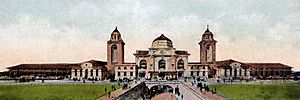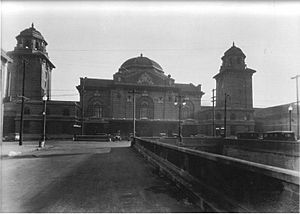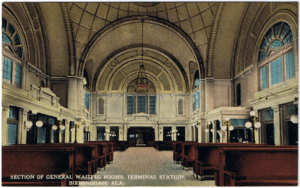Birmingham Terminal Station facts for kids
The Birmingham Terminal Station was a very important train station in Birmingham, Alabama, USA. It was built in 1909 and was the main train hub for the city until the 1950s. Sadly, it was torn down in 1969. Many people in Birmingham still remember it and wish it had been saved. It's a symbol for those who want to protect old buildings.
Contents
Building a Grand Station
In the early 1900s, six out of seven major railroad companies in Birmingham teamed up. They formed the Birmingham Terminal Company. Their goal was to build a brand new, large train station.
This new station cost about $2 million, which was a lot of money back then! It covered two city blocks in downtown Birmingham. The Terminal Station mostly took over from an older station. However, two railroads, the Louisville and Nashville Railroad and the Atlantic Coast Line Railroad, kept their own stations.
Amazing Architecture
The architect who designed this huge station was P. Thornton Marye. He was from Washington, D.C.. The station's design was inspired by Byzantine architecture and the Beaux-Arts architecture style. It looked quite unique and even caused some debate at first because of its unusual style.
The outside of the building was made mostly of light-brown brick. Two tall towers, each about 130 feet (40 meters) high, stood on the north and south sides. The main waiting room was very large, covering about 7,600 square feet (706 square meters). It had a big dome that was 64 feet (20 meters) across. This dome was decorated with fancy tiles and had a skylight made of beautiful glass. The lower part of the walls in the waiting room was covered in gray marble.
Around the main waiting room, you could find many useful areas. There was a ticket office, a separate waiting room for ladies, and a smoking room. You could also find a barber shop, a news stand, and a place to buy refreshments. There were even booths for telephones and telegraphs. Along the north and south sides of the station, there were a kitchen, dining rooms, and restrooms. There was also a separate waiting room for "colored" passengers, which was a requirement due to the strict rules of racial segregation in Birmingham at that time. The north side of the building was used by two freight companies, while the south side handled baggage and mail.
Outside, there were ten train tracks. These tracks and platforms were covered by special "umbrella" sheds. These sheds protected people from rain but still let in sunlight and fresh air.
During the Great Depression, the station became a bit run-down. But it got a new life in the late 1930s and during World War II. In 1943, the station had a big renovation that cost $500,000. It got sandblasted, repainted, and had new things inside. During this busy time, as many as 54 trains passed through the station every day!
Popular Train Services
Many different train companies used the Birmingham Terminal Station. These included the Central of Georgia, Illinois Central, St. Louis-San Francisco (also called 'Frisco'), Seaboard Air Line, and Southern Railway.
Some of the famous passenger trains that stopped here were:
- City of Miami (traveling from Chicago to Miami)
- Seminole (from Chicago to Jacksonville)
- Kansas City-Florida Special (from Kansas City to Jacksonville)
- Sunnyland (from Memphis to Atlanta)
- Birmingham Special (from New York City to Birmingham)
- Pelican (from New York City to New Orleans)
- Southerner (from New York City to New Orleans)
The Station's End
As more people bought cars and air travel became popular, fewer people traveled by train. By 1960, only 26 trains used Terminal Station each day. By early 1969, this number dropped to just seven trains daily.
During the 1960s, the station was also a place where parts of the Civil Rights Movement happened. Local leaders like Fred Shuttlesworth spoke out against the separate waiting areas for different races. Sometimes, angry crowds gathered, and there was even violence.
In 1969, the U.S. Social Security Administration wanted to build a new office downtown. A plan was made to tear down the old station and build a new, smaller train terminal, along with the Social Security building, other offices, and a hotel.
Permission to tear down the station was given on June 30, 1969. Many local groups and people who wanted to save old buildings tried to stop it. However, the commission decided that the old station no longer met the needs of travelers. Within a few months, the building was torn down.
Interestingly, the big redevelopment plans were never fully built. The Social Security Administration built its new office somewhere else in 1974. The land where the station stood became part of the Red Mountain Expressway. This highway connects major roads like U.S. Highway 31 and U.S. Highway 280 with Interstate 20 and Interstate 59. Using the station's site helped save a public housing project that was planned for demolition.
The Surviving Tunnel
Underneath the center of the station, there was an underpass, often called a "subway." This tunnel allowed streetcars to pass by the station and train tracks. In 1926, a large electric sign saying "Welcome to Birmingham, the Magic City" was put up outside the station near the tunnel's west end. This sign was like a welcoming gate for visitors arriving by train. Because of this, 5th Avenue became known as "hotel row," with many restaurants and entertainment spots.
The only part of the demolished station that still exists today is this tunnel. It is now known as the 5th Avenue North tunnel. It carries the road under the highway and railroad tracks.
Images for kids
See also
 In Spanish: Birmingham Terminal Station para niños
In Spanish: Birmingham Terminal Station para niños










